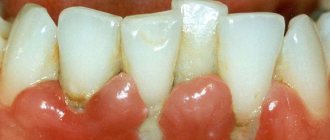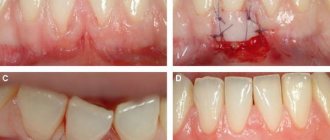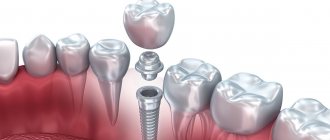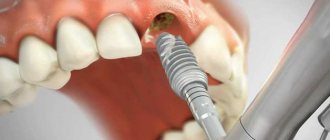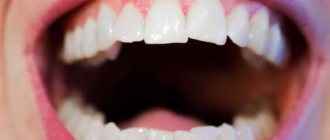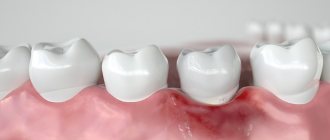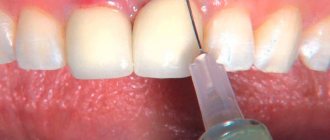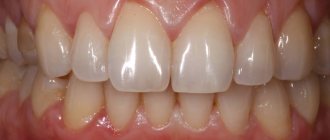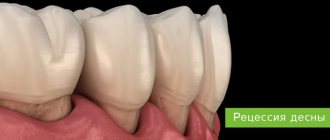From this article you will learn:
- causes of gum inflammation,
- how gums are strengthened at the dentist,
- treatment regimens.
The article was written by a dentist with more than 19 years of experience.
Complaints about weak, loose gums are typical for people with low-grade chronic inflammation of the gums (for example, chronic gingivitis or periodontitis). With a low severity of inflammation, such patients also experience bleeding gums and pain when brushing teeth, as well as swelling, redness or cyanosis of the gum margin.
In moderate to severe forms of inflammation, the above symptoms are gradually joined - periodic discharge of pus from under the gums, increasing mobility of the teeth, exposure of the necks and roots of the teeth. Patients notice that the gums seem to move away from the teeth (Fig. 4), which indicates the destruction of the dentogingival attachment and the formation of periodontal pockets.
What weak, inflamed gums look like: photo
Most often, loose, weak gums are characteristic of patients who have been trying to treat inflammation at home for a long time, using various rinses, gum gels or anti-inflammatory toothpastes. Their independent incorrect use always leads to only a temporary improvement, while the inflammation does not completely disappear, and the condition of the gums continues to slowly deteriorate. In this article we will tell you why this happens and what to do about it.
Features of treatment
Gum recession is a consequence of impaired circulation of periodontal tissues that nourish bone tissue, resulting in bone atrophy and a decrease in gum level towards the root. The difficulty of treatment is that the loss of soft tissues has an extensive etiology and occurs under the influence of a number of factors:
- inflammatory process and accumulation of plaque and granulation tissue in periodontal pockets;
- improper brushing technique;
- errors in prosthetics;
- mechanical damage, chemical and thermal burns;
- malocclusions, poor-quality orthodontic treatment;
- elderly.
Only in the latter case does recession develop independently, that is, as a consequence of the aging of the body and the mucous membrane in particular. In other situations, the disease is provoked by very specific factors, so successful recovery from gum recession is possible only after identifying and stopping the underlying pathology. For example, in case of periodontitis, it is necessary to remove all dental plaque and carry out anti-inflammatory therapy. If the recession is associated with orthodontics, then it is necessary to correct the bite or replace an incorrectly installed brace system. The same applies to prosthetics: often it is low-quality or incorrectly manufactured dentures that contribute to injury and death of soft tissues.
Weak and loose gums: causes
To understand how to strengthen your gums at home, it is important to understand the causes of gum inflammation. If you look carefully at the photos of patients with gingivitis and periodontitis (Fig. 1-6), you will see that in absolutely all photographs in the area of the necks of the teeth or in the interdental spaces you can see accumulations of soft microbial plaque and/or deposits of hard tartar . And this is no coincidence. Inflammation in the gums does not occur on its own - it occurs solely due to the impact of pathogenic bacteria on the gums by microbial plaque and tartar.
Bacteria release various toxins and pathogens, which trigger an inflammatory reaction in the gums. And when you start using various mouth rinses, gum ointments or pastes for bleeding without removing plaque, all this does not in any way affect the cause of inflammation (plaque and tartar), but only allows you to muffle its symptoms. Due to strong active components, swelling and redness of the gums and bleeding are temporarily reduced. At the same time, pathogenic bacteria remaining on the teeth will continue to produce toxins, slowly and less noticeably continuing to destroy the gums.
Important: any antiseptic or anti-inflammatory agents for gums, used without first removing dental plaque, lead only to a temporary reduction in the symptoms of inflammation, but most importantly, to the transition of inflammation into a chronic form and unnoticed progression of the disease.
It is logical that the appearance of dental plaque is associated with insufficient/irregular oral hygiene. But when you start talking about this with patients, almost no one wants not only to admit this fact, but also to change their behavior pattern (dental care). Good oral hygiene includes more than just brushing your teeth after every meal, i.e. 3 times a day, but also be sure to use dental floss to clean the interdental spaces. Therefore, it is very important, among other things, to avoid snacking between meals.
Over the many years of working as a periodontist, I have seen thousands of patients who were willing to spend a lot of time preparing various tinctures, gum massage, all kinds of rinses and applications. But when it came to brushing their teeth, they were not able to spend 5 minutes 3 times a day to properly brush their teeth, first with floss, and then with a toothbrush and toothpaste. Although, it is this, and not various medications, that is the key to healthy teeth and gums.
Yes, and one more important point - looking in the mirror at their inflamed gums, some patients may not see the accumulation of plaque and tartar. How so? - you ask. Not only did they tell me that stones on the teeth are formed not from hard water, but from poor hygiene... there are also no stones on the teeth, but there is inflammation in the gums. What's the matter, doctor? I believed you so much... and then comes a crying emoticon. But the whole point is that hard dental deposits can be not only supragingival, but also subgingival.
In patients with chronic periodontitis, hard dental deposits (tartar) most often form in periodontal pockets, and look like microbial plaques of different sizes, firmly attached to the surface of the tooth root. Such subgingival dental plaque causes even more damage to the gums than supragingival plaque. At the same time, finding and removing them, due to the lack of visual control, is much more difficult and requires a certain skill and perseverance.
In the photo below you can see how teeth with periodontitis that appear to have completely normal gums can actually have a deep periodontal pocket with a large amount of destroyed bone tissue (the second photo was taken after gum detachment). And this destruction was caused by the very subgingival tartar that we indicated with the arrow.
This bone destruction caused by subgingival dental plaque proceeds unnoticed until a certain point - until the amount of bone destruction becomes so large that tooth mobility occurs. In general, after this, all treatment comes down to the fight for survival and an attempt to delay tooth extraction. Therefore, you need to go to the dentist and remove deposits - not when it gets really bad, but much earlier.
Indications for closing gum recession
Elimination of gum recession is necessary when the first visual signs appear, that is, when its free edge drops. In this situation, the only effective way is surgery. Conservative treatment of recession is carried out at the stage when the patient has not yet observed changes in the shape and position of the gingival margin. Analysis of symptoms and diagnostic procedures help identify predisposition to the disease. Increased sensitivity of teeth, inflammation, bleeding, an abundance of plaque and tartar - all these symptoms clearly hint at a pathological process, which sooner or later will lead to more serious complications. Another warning sign is the individual structure of the gums. A narrow and thin layer of attached gum (in simple terms, its base) and a wide root part of the tooth clearly indicate a high predisposition to the development of recession.
Gum augmentation: what is it?
There are many oral diseases: some of them are widespread, and some are much less common. The second example includes cases of gum recession (decay), which requires attention from the dentist. It is this problem that we will talk about in this article, and we will also get acquainted with methods for increasing and closing gum recession.
What is gum recession (loss)?
Sooner or later, a person may face the problem of exposed teeth, which occurs due to a decrease in the volume of gum tissue. It is this process that is called a recession, which is fraught with a potential threat, and quite a serious one. The insidiousness of the disease lies in the fact that the person himself does not feel the development of the problem at all: recession is diagnosed through a visual examination by an experienced dentist.
Gum loss is a sluggish phenomenon that is not felt at all by the patient (except for a slight reaction to changes in food temperature and brushing teeth).
Among other things, some patients consider recession a natural phenomenon associated with age-related changes in the body, leaving this problem without due attention. This can be called a serious mistake fraught with a potential threat. So why does recession occur, and what are the reasons for gum loss? Let's name the main ones:
- Anatomy of the jaw structure;
- Periodontal diseases of various nature;
- Removal and loss of tooth(s);
- Untimely and poor-quality oral hygiene;
- Genetic characteristics (susceptibility to gum recession);
- The presence of bad habits in a person (for example, smoking and love of seeds).
The nature of the development of recession is atrophy of the gum tissue, as a result of which its volume begins to decrease.
Another possible option is the presence of inflammatory processes (mechanical and bacterial origin): the result is similar - the gum tissue decreases in volume, resulting in gum loss.
Symptoms of gum recession
And yet, there are certain symptoms of the development of the disease, knowing which, you can promptly identify the development of a recession. These signs include the following phenomena:
- General symptoms: exposure of tooth roots, reduction in the volume of soft tissues, manifestation of basal caries, increased sensitivity to cold and hot drinks (food);
- Symptoms of traumatic recession: reaction to temperature changes, tooth trauma, tissue reduction by no more than 3 millimeters;
- Symptomatic signs: the appearance of plaque, increased bleeding of the mucous membrane, loose teeth, discoloration of the gums.
If you have noticed the presence of one or more symptoms from the above list, you should immediately contact your dentist.
It is likely that this is not gum recession at all, but another disease, however, the need for treatment remains in any case, since any of these symptoms indicate the presence of a serious problem with the teeth and gums.
Gum extension in Kirov
Gum recession today is treatable, which consists of a augmentation procedure. In Kirov, a similar operation is performed in Dr. Efremov’s Dentistry, whose specialists have extensive experience in solving similar problems.
To fully understand the essence of the procedure, you should consider all possible techniques that are related to closing gum recessions.
First of all, it is necessary to consider the materials used for gum augmentation:
- Xenograft – using materials of animal origin. As a rule, this technique is practically not used today due to the long survival time of tissues;
- Allograft - in this case we are talking about donor tissue that is taken from another person. The difficulty of carrying out an extension operation lies in the need to find a donor;
- Autograft is the patient’s own gum tissue, which is taken from the outgrowths of the chin and lower jaw;
- Alloplast is the most common method based on the use of synthetic materials and compositions. A completely safe and, one might say, gentle method of gum augmentation in Kirov, which is chosen by most dentists, as well as the use of a lateral flap. The material retains the advantages of the methods described above, however, its use is not associated with the use of donor tissue or human tissue.
Surgical treatment of gum recession
So what treatments for gum recession exist today (given the variety of augmentation materials described above)? Let's look at five options related to surgical methods:
- Use of a lateral flap. We are talking about donor areas adjacent to the defect site (applicable only if there is a sufficient amount of materials). This flap is placed over the affected area, allowing the tissue to heal and closing the gum recession;
- Moving the gum flap to the recession site (also in case of sufficient tissue volume). Unlike the first method, the donor tissue is stretched while maintaining natural fixation to the source. That is, this is not an independent flap taken from another area, but an increased length of a fragment of the patient’s gum;
- Use of tissues from the hard palate. This is some kind of alternative to the first method, only in this case it is not the gum tissue that is used, but the palatal tissue;
- Combined techniques that combine the first three methodologies;
- Guided tissue regeneration. For this purpose, special membranes are used that are introduced into the affected area and promote the growth of natural tissue.
Any type of operation described above is performed using anesthesia, therefore, the patient does not experience pain during manipulation.
Disease prevention
To ensure that gum growth is not required (or is diagnosed at an early stage), we advise you to follow simple preventive recommendations:
- You should sign up for Prof. dental examinations every six months. This will prevent the presence of recession, as well as predict the occurrence of other diseases of the teeth and oral cavity;
- Caries should be treated in a timely manner, since the presence of root disease is one of the key reasons for the development of gum recession;
- Careful oral hygiene using suitable toothbrushes and toothpastes;
- You should avoid trauma to the gums, including the use of excessively hard brushes, which causes bleeding gums;
- The appearance of recession, which you noticed, will certainly lead to the scaling of the problem, since the loss of gum tissue itself does not stop. On the contrary, over time the volume of affected tissue will only increase.
Today, operations to increase and close gum recession in Kirov are carried out at Dr. Efremov’s Dentistry.
This is a very common problem that has effective and painless treatment. Sign up for a consultation at Dr. Efremov’s Dentistry and get answers to all your questions regarding gum tissue extension in Kirov! Information by phone: 8 (8332) 255-717 . Be healthy and take care of the beauty of your smile!
How to stop gum recession?
Therapeutic treatment of gum recession is aimed primarily at eliminating the inflammatory process, normalizing the microflora of the oral cavity, increasing immunity and the body's protective properties.
Therapeutic techniques
- Professional cleaning and sanitation of the oral cavity.
It is used as a preventive measure, and is also the first step in the treatment of the inflammatory process. - Closed curettage of periodontal pockets.
A therapeutic procedure for removing dental plaque in periodontal pockets. - Treatment of gum recession with laser.
Photodynamic laser therapy or laser curettage is performed. - Anti-inflammatory therapy.
The doctor prescribes gels, ointments and rinses (usually topical use), which have antimicrobial and anti-inflammatory properties. - Antibiotic therapy.
- Taking vitamins and supplements.
During recession, vitamins C, D, B9 are prescribed, as well as preparations containing the protein amelogenin, which helps restore soft and hard tissues.
Surgery
- Treatment of damaged tissues and suturing.
The simplest manipulation that is performed during recession, when the gums are damaged as a result of mechanical stress. - Flap surgery.
Gum recession plastic surgery, when donor tissue is taken from a healthy area of the mucous membrane to “close” the missing fragment. Allows you to restore 2-3 millimeters of the level of the mobile gum. The advantage of this technique is the relative speed of the operation and a completely acceptable result. Disadvantages: invasiveness, the need to collect donor tissue and the possibility of rejection. In some situations, the color of the donor tissue may be slightly different, which negatively affects the aesthetics. - Tissue regeneration.
It is carried out using a fibrin membrane - a tissue growth stimulator, which resembles a dense clot and is implanted into the site of recession after preparatory surgical procedures. To produce the membrane, blood is required from the patient, but the healthy area of the gum is not harmed (unlike flap surgery). This technique has a number of advantages: minimally invasive, the possibility of treatment in complex cases, rapid tissue restoration and the absence of the risk of repeated recession. The gums after surgery to eliminate recession look healthy and natural. - Treatment of gum recession with collagen.
Implantation of collagen implants of natural origin for tissue restoration. The implants contain fibrillar protein, which is the basis of connective tissue. Previously, collagen was removed after treatment, but modern implants do not require this and dissolve on their own. This method is especially effective for age-related recession.
Strengthening gums at home: drugs, methods
As we said above, the best way to strengthen gums is proper and regular oral hygiene. However, there are a number of remedies that can further help you - improve the condition of your gums. Such products should not contain antiseptics and antibiotics, because the latter should be used only in short and infrequent courses (24stoma.ru).
High-quality oral hygiene –
In short... Teeth should be brushed after every meal, including lunch. To brush your teeth, you must first use dental floss, without which nothing will ever allow you to clean the interdental spaces from rotting food debris (toothpicks and mouth rinse are ineffective for this). At lunchtime, good hygiene involves a combination of dental floss + chewing gum. But if you no longer have gingivitis, but periodontitis, we advise you to have a second set of toothbrush and toothpaste at work.
You need to brush your teeth not 15 minutes after eating, but within the first 5 minutes. If you are visiting, at a restaurant, or outdoors, you should always have dental floss and a pack of chewing gum in your purse/pocket. It is very important to avoid snacks between main meals - no cookies, chocolate buns, etc. (apples that are not too soft are fine). If you eat candy, you need to brush your teeth. These are the simplest basic rules, the implementation of which is much simpler than the expensive and lifelong treatment of chronic periodontitis.
How to use dental floss and brush correctly -
Important: If you have crowns and bridges on your teeth, or if you have diagnosed periodontitis with deep periodontal pockets, be sure to use a home irrigator to rinse periodontal pockets and clean artificial crowns (in addition to basic hygiene methods). The cost of the irrigator will be 3-5 times cheaper than the cost of splinting mobile teeth, and also 10-20 times cheaper than the cost of open curettage of periodontal pockets.
Toothpastes for weak gums –
Such toothpastes can be divided into 2 groups. The first group of pastes contains potent antiseptics (usually chlorhexidine), and it is undesirable to use them for more than 2-3 weeks. It is optimal to use such pastes only as part of complex therapy during professional treatment of gingivitis/periodontitis at the dentist. Such pastes are good for relieving bleeding and swelling of the gums, and you can read more about them here .
But such pastes are not suitable for constant use, and their uncontrolled use can even cause harm (such pastes only suppress the symptoms of inflammation, making a person think that everything is fine). Therefore, to strengthen the gums, not antiseptics are used, but mild anti-inflammatory agents - extracts of medicinal plants, thymol, eugenol, clove oil, eucalyptol, bisabolol, allantoin, phenyl salicylate, as well as sodium fluoride.
a) Toothpaste “Parodontax-F” –
instructions for use- manufacturer - UK,
- active ingredients – extracts of echinacea, peppermint, sage, myrrh, chamomile, ratania, mineral salts, zinc citrate,
- fluoride content – 1400 ppm,
- price from 150 rubles (75 ml tube).
Comments: Parodontax toothpaste has a formulation that has remained unchanged since approximately 1890. This is a natural toothpaste that contains high concentrations of medicinal plant extracts and mineral salts, which have a pronounced anti-inflammatory and astringent effect, due to which gum bleeding is reduced. Unlike many others, these pastes can be used on an ongoing basis to treat and prevent gum inflammation (due to the fact that they do not contain antiseptics).
b) Toothpaste “Parodontocide” –
instructions for use- manufacturer – Russia,
- active ingredients – mint and sage extracts, thymol, eugenol, allantoin, phenyl salicylate, sodium fluoride,
- fluoride content – 1000 ppm,
- price from 120 rubles (50 ml tube).
There are other good anti-inflammatory toothpastes besides the ones listed above. You can independently evaluate the compositions of pastes, taking into account our recommendations for active ingredients made above. However, an important point is not only the names of the active ingredients, but their concentration in the paste. And in the above pastes there is a fairly high concentration of medicinal plant extracts, as well as other medicinal components.
Treatment at home
Treatment of gum recession at home is impossible, since in advanced stages of the disease only surgical intervention can correct the situation. It is not possible to get rid of gum recession with ointments, gels and tinctures: at best, they will help cope with inflammation, but they cannot restore the edges of the gums. Anti-inflammatory therapy is used only as an addition to the main treatment. Folk remedies should be used only on the recommendation of a doctor or as a preventive measure. In the absence of pharmaceutical drugs, folk remedies may provide some benefit. A solution based on soda and salt, propolis extract, decoctions of oak bark, juniper and chamomile are just a small part of the folk recipes that can be used for gum diseases.
What to do to prevent the disease?
Preventive measures do not provide a 100% guarantee that you will never experience gum recession, but following them will help minimize the risks:
- regular and high-quality hygiene;
- professional cleaning of dental plaque;
- using a medium-hard toothbrush and proper brushing technique;
- timely diagnosis of caries and inflammatory processes;
- taking vitamins and amelogenin if there are risks of recession;
- giving up bad habits, especially smoking;
- correction of malocclusions, if you have them.
